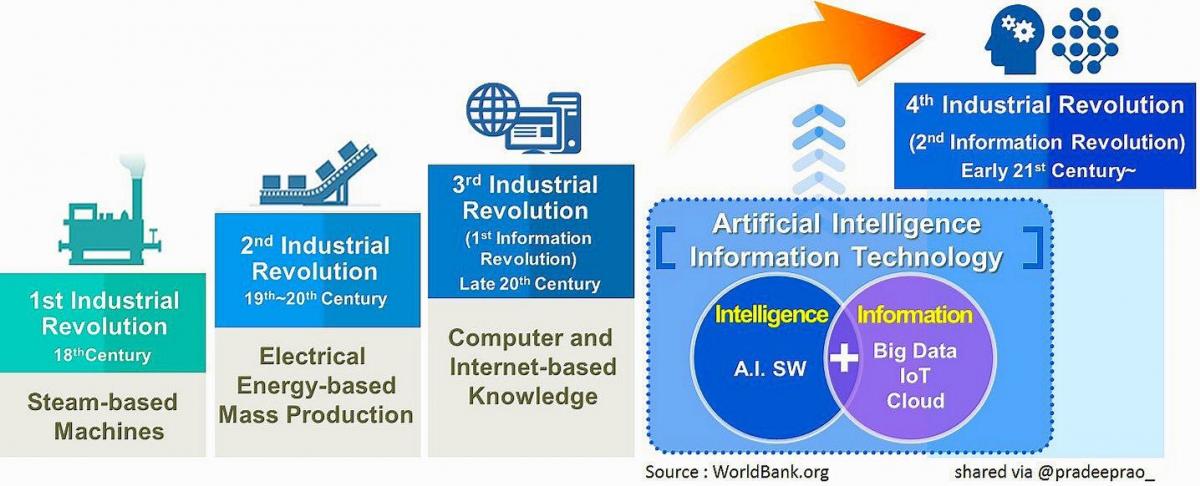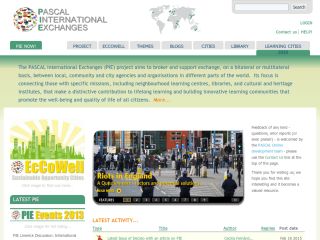Being human in the era of the fourth industrial revolution and AI
The recent PASCAL and PIMA report on Good Active Ageing, which I edited with Denise Reghenzani Kearns, discussed the implications of the convergence of the demographic and technological revolutions. The demographic revolution with ageing populations is occurring at a time when revolutionary changes in digital technologies associated with artificial intelligence, robotics and biotechnologies are impacting on society with this impact certain to increase. How soon superintelligence arrives is a matter of lively discussion.

This throws up the question of what it means to be human in this context which I have addressed in the attached short article. This is an important question that I hope we can discuss in both PASCAL and PIMA contexts, including the question of rethinking our approach to lifelong learning.
Peter Kearns
The following article first appeared in PIMA Bulletin 23...
Being human in the era of the Fourth Industrial Revolution
& artificial intelligence
The articles in the last issue of the PIMA Bulletin on deep lifelong learning reminded me of the looming debate on what it is to be human in the emerging machine age of the Fourth Industrial Revolution driven by artificial intelligence, robotics and biotechnologies.
This question is receiving growing attention. The magazine New Philosopher devoted its recent issue to this subject with a range of perspectives - when? how? why? In an issue titled Being human: All about us. While the questions are certainly philosophical, they also raise some very practical issues for a wide range of social pursuits, including education. What makes us human in the machine age? How do we distinguish human intelligence from machine intelligence? How do we use lifelong learning and community building strategies to enhance essential human attributes and needs in the looming machine age?
If in Life 3.0 (or Society 5.0 call it what you will), there is less work for all, or indeed no work except for machines, and if the current trends in community breakdown continue, what will replace the traditional things that brought meaning and purpose to lives. Learning for what purpose? What will be the features of Life 3.0 that we need to direct our ideas on education towards?
The founder and CEO of the World Economic Forum, Klaus Schwab, offers some useful pointers, starting with the question of distinguishing human and machine intelligence. He suggests a concept of human intelligence with four parts:
- Contextual intelligence –the mind;
- Emotional intelligence – the heart;
- Inspired intelligence – the soul;
- Physical intelligence – the body.
I find this a useful starting point in thinking about human and machine intelligence. If we take inspired intelligence to mean spiritual, as I do, I think we have a useful framework to explore what makes us human that machines will not achieve – at least not in the present state of technology development.
Schwab follows up with the following observation in discussing “inspired” intelligence
It focuses on nourishing the creative impulse and lifting humanity to new collaborative and moral consciousness based on a shared sense of destiny.
This concept leads easily to objectives such as compassion, empathy, and inclusion that are familiar to educators. Martha Nussbaum adds to this perspective by asserting that “it will need an ethical revolution, a consciousness-raising effort of international proportion”. How do we move towards such objectives?
A starting point is offered by the recent PASCAL/PIMA report on active ageing which takes us in such directions. These features include the following:
- A values-led approach to active ageing (and all other phases of life);
- Using the UN Sustainable Development Goals as a testing ground in developing such an approach through an evolutionary approach starting with the education Goals;
- Using local learning communities as the place to start an ethical revolution;
- Revitalizing learning and community building together in a triple helix approach.
These points were brought together in a line from the UNESCO 2017 Cork Call to Action on Learning Cities.
We aspire to build a mindful learning culture in our cities that fosters global consciousness and citizenship through local action to implement the SDGs.
There is much that adult education, with learning communities and other partners can do to foster such a values-led approach. Building a mindful learning culture is a long term investment that needs to be fuelled by democratic humanistic values and participation.
I saw this 20 years ago when the late George Papadopoulos and I undertook a study of policies adopted by five OECD countries to build a learning and training culture: Sweden, Germany, USA, UK, and Netherlands. The democratic values enshrined in Swedish Folk High Schools later found expression in other things the Nordic countries have done to build a democratic learning culture, and have further found expression in the things discussed in the recent PASCAL/PIMA SIG report such as Volkshochschulen in Germany, Kominkan in Japan, Neighbourhood Houses in Australia, and various U3A and learning city initiatives.
If the pessimistic forecasts of the impact of artificial intelligence on employment are realized- or even partly realized- we are heading for the critical challenge described by MIT physicist Max Tegmark in the following terms:
To create a low-employment society that flourishes rather than degenerates into self-destructive behavior.
So what can we do in this transition period towards Life 3.0/Society 5.0 by harnessing our lifelong learning strategies to develop such well-being-inducing strategies that add meaning and purpose to lives?
Again, the recent PASCAL/PIMA report offers some suggestions and may be regarded as an opening salvo in shifting our thinking towards the needs of a thriving low-employment society and the steps we need to take in this transition phase in asserting the things that make us human.
Can we, however, make the leap from good active ageing to good active living in all stages of life fuelled by the four types of human intelligence identified by Schwab: contextual, emotional, spiritual, physical? I am inclined to the optimistic view that the spin-off effects of achieving a renaissance in learning in later life will impact, in various ways, on the earlier stages of the life journey.
It is useful in this regard to look at Japan which is leading in responding to an ageing population and building a sustainable society named Society 5.0 by the Japanese government, a human-centred society that integrates cyberspace and physical space. The critical point is that a social vision is leading, not technology. Atushu Makino in his article on Kominkan in the SIG report discusses how the Kominkan network of community learning centres is serving as the basis of a decentralized revitalization of Japanese society which he terms “a new infrastructure for society in Japan”.
In moving in such directions, a further important point that emerges from the SIG report, is that we need to revitalize individual learning and community learning together. This gives a key role for approaches such as community learning centres and learning communities and cities. A range of options are discussed in the SIG report, but others exist such as where a network of centres are supported by a foundation, as in several American examples.
Diana Amundsen in PIMA Bulletin 22 cites Belanger in recognizing that our vision of lifelong learning must change in response to the transformation of situations requiring lifelong learning.
But as Belanger proposes, our vision of lifelong learning must be extended, broadened and deepened in response to the situations calling for lifelong learning undergoing transformation.
We are clearly in such a situation where the concurrence of the demographic and technological revolutions, along with other changes, is creating a never before situation requiring creative responses. I am suggesting that some deep thinking on what makes us human, and which distinguishes us from machine intelligence, should be at the forefront of our thinking on the kind of Society 5.00 that is needed.
The challenge is immediate and critical. Nick Bostrom, director of the Oxford Future of Humanity Institute, poses the challenge in stark terms.
Before the prospect of an (machine) intelligence explosion, we humans are like small children playing with a bomb. Such is the mismatch between the power of our plaything and the immaturity of our conduct. Superintelligence is a challenge for which we are not ready now and will not be ready for a long time. We have little idea when the detonation will occur, though if we hold the device to our ear we can hear a faint ticking sound.
On the other hand, French public intellectual Bernard-Henry Levy sees the challenge in more positive terms as an opportunity.
When we instead commit ourselves to moving forward, to diving into the unknown and embracing our humanity in all its uncertainty, then we embark on a truly beautiful and noble adventure- the very road to freedom.
So does the future lie with a ticking bomb, a re-run of Mary Shelley’s Frankenstein, or a beautiful and noble adventure?
In thinking about these scenarios I find myself going back to the 1972 UNESCO Faure Commission report with its existential philosophy of learning to be, and the idea that “man is an unfinished product that only fulfils himself through learning”.
Education from now on can no longer be defined in relation to a fixed content which has to be assimilated, but must be conceived as a process in the human being, who thereby learns to express himself, to communicate and question the world, through his various experiences, and increasingly-all the time- to fulfil himself.
So in terms of the subject of this article, learning to be becomes learning to be human. The process of lifelong learning being directed at the qualities that make us distinctively human with the four intelligences identified by Schwab being expressed in imagination, compassion, empathy, autonomy, citizenship- and creativity, so as to give meaning and purpose to our lives and empowerment to individuals and communities
I welcome comments on this short article which I have linked to the report of the PASCAL/PIMA SIG report on active ageing which Denise and I edited. This is a very important subject that merits our close attention.
Peter Kearns
| Attachment | Size |
|---|---|
| being_human_in_the_era_of_the_fourth_industrial_revolution_-_peter_kearns.pdf | 128.97 KB |
 Printer-friendly version
Printer-friendly version- Peter Kearns's blog
- Login to post comments






